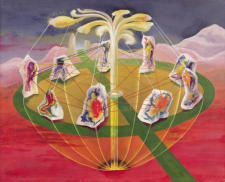



All texts copyright Richard Shillitoe
dance of the nine opals
1942
Oil on canvas.
22½ x 28in. (51 x 69cm.)
Signed and dated: ‘Colquhoun/42’ lower left.
Provenance
Sotheby’s, studio sale, 24 April 1985, lot 524.
Mr. & Mrs. Michael Pruskin.
Christie’s, 22 May 1996, lot 37.
Private collection.
Exhibited
London, London Museum, 1942, no. 3.
Leicester, City Museum, 1942, no. 48.
Derby, Art Gallery, 1945, no. 89.
London, Hampstead Artists’ Council, 1947, no. 48.
Travelling, Society of Mural Painters, 1950, no. 14.
London, Hampstead Town Hall, 1960, no. 24.
London, Leva Gallery, 1974, no. 15.
Penzance, Newlyn Gallery, 1976, no. 12.
London, Blond Fine Art, 1985, no. 41.
Canterbury, The Herbert Read Gallery, 1986, no. 80, ill. col.
Finland, Retretti Art Centre, 1987, ill col.
Leeds, City Art Gallery, 1999.
Wolfsburg, Kunstmuseum, 2002-03, ill. col. pl. 88.
Middlesbrough, Institute of Modern Art, 2008, ill. col. p. 90.
Leeds, City Art Gallery, 2009, ill. col. p. 139.
Literature
From letters to J.F. Hendry (17 April 1947, University of Glasgow Special Collections MS Gen 549/529 and
1948 MS Gen 549/531) it is clear that Colquhoun was negotiating to sell this work to Hendry. As the work
remained in the artist’s possession until 1985, the sale was not successful.
Remy, 1999, ill. col. pl. 121, discussed p. 244.
Ratcliffe, 2007, ill. b/w pl. 30.
Morrisson, 2014, ill. col. p. 602.
Shillitoe & Morrisson, 2014, fig. 5.
The work is partly naturalistic and partly imaginative. The stone circle is based on the Merry Maidens stone
circle, only a few miles from Colquhoun’s home near Penzance, Cornwall. The tall stones in the background
are based on the Pipers, a pair of standing stones that are adjacent to the circle and which may be
associated with a ceremonial causeway leading to it. In legend they are the petrified remains of musicians
who played for dancing girls. The mountain range in the background that encloses the site, making it a
special place, is an invention. The artist has reduced the number of stones in the circle from nineteen to
nine. Nine is the number of creation and the Opal is the October stone. Another allusion is to Colquhoun’s
own birthday, which was 9th October.
A stream of energy wells up from a subterranean source and arcs into tendril- and feather- like forms at
the top of its stream. In this way, the hidden currents and relationships become visible reality. The lines
stream like spiritual bridges, incorporeal yet visible, occupying yet creating space. This device, of
connecting key points by lines of force, was used by Colquhoun in other works of this period, including The
Sunset Birth (ca. 1942), which shows another Cornish megalithic monument.
Colquhoun herself analysed the painting, in an essay written shortly after its completion:
This painting, it seems to me, comes from some hinterland of the mind, some border-line
region, since elements drawn from both ‘actual’ and ‘potential’ worlds are to be found in
it. It is built from several impacted strata of material and meaning:
1) Various druidic stone-circles known to Cornish folk-lore as ‘Nine Maidens’ (ni mên =
‘holy stones’). Legend says that the circle is composed of girls turned to stone for
dancing on (at) the Sabbat, and can be restored to natural shape if embraced at
midnight when the moon is full. The monument is a petrified ‘Hexentanz’; it is here
seen as one of the ‘psychic zones’ of the country-side, one of its ‘fountains out of
Hecate’.
2) A Celtic solar festival or fertility-rite; the Maypole’s streamers are replaced by coloured
‘lines-of-force’ connecting the stones with the central fountain and with each other.
3) The nine planets of traditional astrology, including Pluto and Vulcan, revolving round
the cohesive and dynamic force of the solar system.
4) Apollo, symbolised by the sun-burst in the centre of the ring, ‘leading his choir, the
Nine’.
5) The common chord, symbolised by the three tints – one of them basic – in each stone,
carried through an octave, including the first two accidentals. The ‘music of the
spheres’.
6) Kether (‘the crown’) mitigating the nine lesser sephiroth – often rep-resented in
cabalistic tradition as a tree of life.
7) A supernatural flower with nine petals and fiery pistil.
8) The nine moons of pregnancy with perpetual solar impregnation.
9) The opal signifying by its combination of colours the animal, vegetable and mineral
worlds. By its connection with the Zodiacal Libra, it links the whole morphological
system with the idea of a balance between static and dynamic forces.
(TGA 929/2/1/17).
Additional meanings and sources of the imagery are entirely possible. Jay Cruikshank (pers. comm.) points
persuasively to a passage in the Crying of the Wind concerning phantasmal forms seen in the countryside,
where Colquhoun describes one of her own sightings of these eerie beings: I have myself seen in Cornwall
one like a massive pillar of unknown substance, with filaments stretched from the top seemingly to hold
it to the ground like the guy-ropes of a tent (p. 23.)
A watercolour study is known.


















